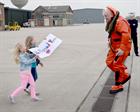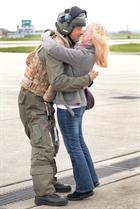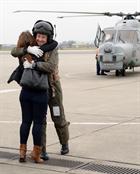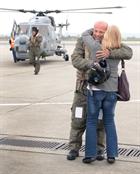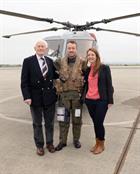HMS Montrose's Lynx flight returns home
Lynx Flight embarked in HMS MONTROSE has returned home on 11 March following a 7-month operational deployment that has seen her travel over 32,000 miles and visit 12 different ports in 10 different countries.
Aircrew from 815 Naval Air Squadron (NAS) deployed in August last year, arrived back at Royal Naval Air Station (RNAS) Yeovilton to a warm welcome from family, friends, colleagues and two little girls Lexi Roe(4) and Ellie Roe (6) clearly oblivious to significance of the deployment simply excitedly awaiting their Daddy, Chief Petty Officer Paul Roe.
When asked how much they had missed their Daddy Ellie said “I have missed my Daddy 3088 much”. Not to be out done Lexi said “well I have missed him 4 billion and 1000”. Apparently not as much as the family dog Murphy who Ellie says “face timed Daddy all the time while he was away”! As the two little girls raced to be with their Daddy it marked the end of 7 months of hard work and tasking.
MONTROSE initially sailed into the Mediterranean with a number of other warships as part of the Response Force Task Group (RFTG) COUGAR 13 deployment, to exercise the ability to operate and project power. From there the ship moved into the Persian Gulf as the UK’s primary deterrence and presence patrol in the region, conducting maritime security and reassurance patrols alongside partner nations in the region; safeguarding the sea lanes of the Middle East.
A New Year brought new tasking as the Type 23 Frigate was directed to reposition into the Eastern Mediterranean to join Operation RECSYR – the Danish-led mission to remove chemical weapons from Syria. Flight Commander Lieutenant Joe Sharples said “7 months is a long time for the aircrew, working long and intense days at a high state of readiness, but the work was very rewarding and no two days were the same”.
After arriving off the coast of Syria in mid January, MONTROSE, together with the multi-national task group of warships from Denmark and Norway, have carried out escort and close protection duties of two merchant vessels, as they transported their toxic cargo out of Syria and through the Mediterranean Sea for onward destruction. The mission also involved close co-ordination and interaction with Russian and Chinese warships operating in the area, a new experience for many of the 200 men and women in the ship.
AET Carwyn Jones, part of the ship’s Lynx helicopter Flight from 815 Naval Air Squadron, and on his first deployment, said, ‘It’s been a challenging 7 months and when we left Plymouth I definitely didn’t expect to end up patrolling the coastline of Syria. Overall it’s been a great experience for my first tour and I’m extremely proud of what we’ve achieved.’
Commander Parkin commented, ‘I am incredibly proud of my Ship’s Company who have committed themselves to the changing circumstances of this deployment and the professionalism that this mission has demanded. From our work in the Gulf, to our time on RECSYR, the deployment has been a definitive success in every one of the many tasks that my team have undertaken”.
During this successful deployment the Lynx air crew has travelled 15,000 miles through the air at speeds of up to 180 miles an hour having burnt 50,000 kgs of fuel. It is now time to take some well-earned leave with their loved ones.
A few facts and figures
The ship has travelled 32131 nautical miles, at speeds of up to 30 kts.
The ship has been away from the UK for 212 days.
Over the course of the deployment MONTROSE has burnt 3,763000 litres of fuel.
MTRO has produced 2943 tonnes of fresh drinking water (converted from sea water), enough to fill an Olympic sized swimming pool.
The ship’s Lynx helicopter has burnt 50,000 kgs of fuel, and travelled 15,000 miles through the air at speeds of up to 180 miles an hour.
8 members of the Ship’s Company have had babies born while we’ve been away.
5 members of the Ship’s Company have proposed while away and are now engaged to be married.
The ship has received 786 bags of mail weighing in at a combined total of 6 tonnes.
The Ship’s Company has consumed:
Over 12 tonnes of potatoes, equivalent to the weight of a double decker bus.
2700 Kg of baked beans, equivalent to the weight of 2 cars.
1263 Kg of sausages, which are approximately 2.224 Km in length.
24480 Eggs, which is enough for a very big omelette.
925 Kg of Bacon, enough to keep the Danish in business for a while.
6828 litres of milk, which is more milk than a cow produces in a year, and would fill the Commanding Officer’s bath 50 times.
The ship has visited Greece, Djibouti, Bahrain, Kuwait, Abu Dhabi, Dubai, Ras Al-Khaimah, Cyprus, Malta and Gibraltar.
The ship has hosted royalty (in Ras Al-Khaimah), one UN diplomat (Ms Sigrid Kaag), and a number of other senior military and diplomatic VIPs.
HMS MONTROSE
HMS MONTROSE was deployed on a 7 month deployment overseas from August 2013, initially as part of the Response Force Task Group (RFTG) annual COUGAR deployment, but then acting as the UK’s primary deterrence and presence patrol in the Middle East, Operation KIPION. In January 2014, the ship repositioned to the Mediterranean to participate in the Danish-led operation to remove chemical weapons from Syria, Operation RECSYR.
MONTROSE is a Type 23 Duke Class frigate built at Yarrows on the Clyde and launched in 1992. She has a crew of 185 men and women. Although this class of frigate was designed primarily for the anti-submarine warfare role, MONTROSE is now designated as a “general purpose frigate” and is fitted with a broad suite of the latest sonar, radar and communications systems. HMS MONTROSE carries a Mk 8 Lynx helicopter and her armament includes Sting Ray torpedoes for anti-submarine warfare, Vertical Launch Sea Wolf missiles for air defence, and Harpoon missiles and the 4.5inch gun for anti-surface warfare and naval gunfire support onto land.
Operation RECSYR
Operation RECSYR marks the culmination of the diplomatic efforts to eliminate the chemical weapons programme of the Syrian Arab Republic, following the decision of Syria to ratify the Chemical Weapons Convention in October 2013, and the adoption of United Nations Security Council Resolution 2118, which called for the expeditious destruction of the Syrian chemical weapons programme.
In order to provide a robust framework for the implementation of this resolution, the Organisation for the Prohibition of Chemical Weapons (OPCW) formed a joint mission with the United Nations (OPCW-UN) with the mandate of overseeing this task in the safest and most secure manner possible. The Syrian Authorities are organising the ground movement of the so-called “precursor chemicals” to the port of Latakia where they will be transported to the two chartered RO-RO ferries (MV TAIKO and MV ARK FUTURA) for onwards destruction.
The role of the naval escorts such as HMS MONTROSE is to protect these ships from harm, while they are in international waters, and - when the loading is complete - ensure their safe passage to the port of Gioia Tauro in Italy, where certain materials can be transferred from the cargo ships to a US Government-owned vessel (the MV CAPE RAY) which is fitted with specialist destruction equipment aboard. As announced by the Foreign and Commonwealth Office in December, some of the other chemicals removed from Syria will be taken to the UK for destruction.

